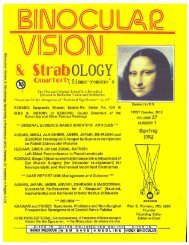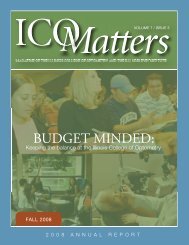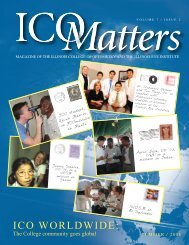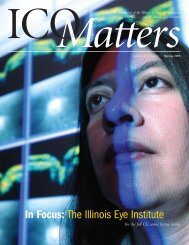Correspondence - ICO Library
Correspondence - ICO Library
Correspondence - ICO Library
You also want an ePaper? Increase the reach of your titles
YUMPU automatically turns print PDFs into web optimized ePapers that Google loves.
-38-<br />
Binocular Vision & A Novel New [Yet Again] Procedure for Correction of FIRST Quarter of 2011<br />
Strabology Quarterly© Com pensatory Head Posture in Infantile Nystagm us: Augm ented Anderson Plus Volum e 26 (No.1)<br />
A M edical Scientific e-Periodical J. E. Bishop, M D Pages 37-42<br />
INTRODUCTION<br />
Compensatory head posture associated<br />
with infantile nystagmus is well described.<br />
Classic approaches for correcting an abnormal<br />
head posture, a head (face) turn with gazeshifting<br />
surgery include the Kestenbaum<br />
procedure (1), and the Anderson procedure(2).<br />
Others have advocated nystagmus<br />
reduction procedures to achieve head posture<br />
correction. Helveston (3) suggested maximal<br />
four horizontal rectus recessions. Dell'Osso<br />
and Hertle (4) described four horizontal rectus<br />
tenotomy and reattachment surgery for<br />
nystagmus damping. More recently, last year,<br />
Hertle et al (Binoc Vis Strab Q. 25:72-93,<br />
2010) reported seven subjects who underwent<br />
an Anderson procedure combined with<br />
tenotomy and reattachment of the remaining<br />
horizontal rectus muscles (5). See discussion<br />
on page 39,40 for further details of<br />
background history.<br />
This report describes the author's contemporaneous<br />
detailed experience with combining<br />
the gaze-shifting principle of an augmented<br />
Anderson procedure with the nystagmus<br />
reducing principle of tenotomy and reattachment<br />
of all four horizontal rectus muscles.<br />
SUBJECTS and METHODS<br />
Under Driscoll Children’s Hospital<br />
Institutional Review Board approval, and in<br />
compliance with the requirements of the<br />
United States Health Insurance Portability and<br />
Privacy Act, (HIPPA) the clinical records of<br />
five subjects receiving simultaneous gazeshifting<br />
and nystagmus reduction surgery<br />
were retrospectively reviewed.<br />
All patients had onset of horizontal<br />
nystagmus in early infancy which remained<br />
horizontal in upgaze and did not produce<br />
oscillopsia. None had serious visual loss,<br />
structural signs of albinism, optic nerve<br />
hypoplasia, photophobia or paradoxical<br />
pupillary phenomena to suggest a congenital<br />
retinal dystrophy. None had neurologic<br />
disease or developmental delay.<br />
All procedures were performed by the<br />
author between July 2009 andJuly2010. With<br />
parental informed consent, all patients<br />
received an augmented Anderson procedure<br />
(recessing one medial rectus muscle 7-8 mm<br />
and recessing the contralateral lateral rectus<br />
muscle 9-10.5 mm) combined with tenotomy<br />
and reattachment surgery on the remaining<br />
two horizontal rectus muscles. Pre- and postoperative<br />
head posture, nystagmus and<br />
monocular best-corrected visual acuities were<br />
assessed by the author solely employing<br />
clinical observations, measuring head turn<br />
with a goniometer.<br />
RESULTS<br />
The five subjects consisted of three<br />
males and two females with typically habitual<br />
abnormal head posture secondary to idiopathic<br />
infantile nystagmus, aged 25-141 months<br />
(mean 64 months, median 56 months). The<br />
Table, top next page, outlines the clinical<br />
data. Pre-operative horizontal head turn ranged<br />
from 14° to 40° (mean 19.6°, median 19°).<br />
Postoperatively, all their head turns<br />
were improved, with a residual same-sided<br />
head turn range of 2° - 11° (mean 4.2°, median<br />
3°). Mean correction was 79% of the preoperative<br />
angle. The net angle of correction<br />
ranged from 10° - 29° (mean 17.4° and median<br />
17°). Follow-up ranged from one day<br />
(subject lost to follow-up) to 345 days, with a<br />
mean of 132 days and a median of 48 days.<br />
Monocular visual acuity improved by<br />
one Snellen line in three eyes, improved less









